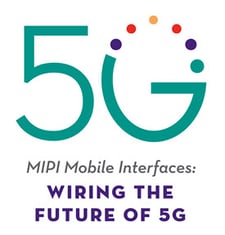5G
Application Areas
Overview
Today, virtually all smartphones – along with many tablets, connected vehicles and Internet of Things (IoT) devices – use at least one MIPI interface. This broad, deep adoption by mobile and mobile-influenced industries continues as 5G devices become more prevalent, too.
A Long History of Enabling the Future
 All MIPI specifications relevant for applications in mobile platforms are designed to meet the bandwidth, performance and feature requirements of 5G. This 5G readiness is due to MIPI Alliance’s long history of anticipating future marketplace requirements and then creating specifications that enable device vendors and their suppliers to meet requirements as soon as they emerge. For example, the first MIPI interface provided connectivity between application processors and cameras and displays, thus enabling the first camera phones and virtually every one since.
All MIPI specifications relevant for applications in mobile platforms are designed to meet the bandwidth, performance and feature requirements of 5G. This 5G readiness is due to MIPI Alliance’s long history of anticipating future marketplace requirements and then creating specifications that enable device vendors and their suppliers to meet requirements as soon as they emerge. For example, the first MIPI interface provided connectivity between application processors and cameras and displays, thus enabling the first camera phones and virtually every one since.
Systems designers use these and other MIPI specifications extensively for their devices, so there’s no learning curve to implement them in their 5G solutions. This enables them to get their 5G products to market quickly and cost-effectively.
MIPI working groups are continually developing new specification versions to ensure that the interfaces continue to anticipate and meet future marketplace needs and requirements. One example is the MIPI RFFE Working Group, which is developing new RF front-end capabilities such as higher data rates, more transmitter/receiver paths and more flexible programmability.
White Paper Explores 5G Readiness
In 2018, MIPI released Making the 5G Vision a Reality: A 5G Readiness Assessment of MIPI Specifications. This white paper details how key MIPI specifications meet industry bandwidth, performance and feature requirements for a wide variety of 5G use cases, starting with smartphones.






